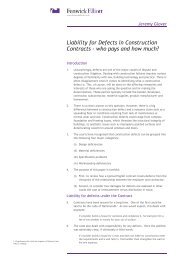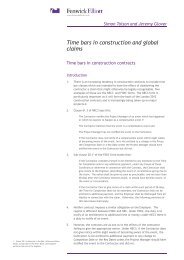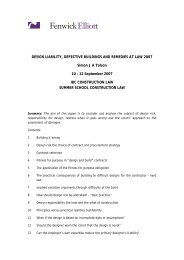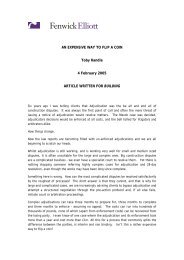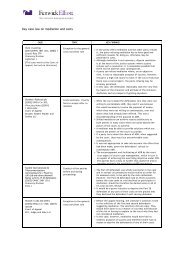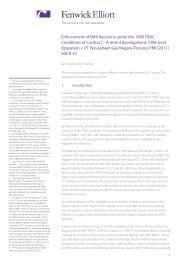Standard forms: JCT 2005, NEC3 and the Virtual ... - Fenwick Elliott
Standard forms: JCT 2005, NEC3 and the Virtual ... - Fenwick Elliott
Standard forms: JCT 2005, NEC3 and the Virtual ... - Fenwick Elliott
You also want an ePaper? Increase the reach of your titles
YUMPU automatically turns print PDFs into web optimized ePapers that Google loves.
<strong>St<strong>and</strong>ard</strong> <strong>forms</strong>: <strong>JCT</strong> <strong>2005</strong>, <strong>NEC3</strong> <strong>and</strong> <strong>the</strong> <strong>Virtual</strong> Contract<br />
www.fenwickelliott.co.uk<br />
NEC<br />
The NEC is a major attempt to draft a simple <strong>and</strong> direct st<strong>and</strong>ard form contract from first<br />
principles without attempting to build upon <strong>the</strong> st<strong>and</strong>ards <strong>forms</strong> that already exist. The<br />
authors of <strong>the</strong> NEC ga<strong>the</strong>red under <strong>the</strong> auspices of <strong>the</strong> ICE, <strong>and</strong> were principally led by<br />
Dr Martin Barnes. The specification prepared by him in 1987 set out <strong>the</strong> aims of those<br />
drafting <strong>the</strong> NEC. These included:<br />
• To achieve a higher degree of clarity when compared to o<strong>the</strong>r existing<br />
contracts;<br />
• To use simple commonly occurring language <strong>and</strong> avoid legal jargon;<br />
• Repeat identical phrases if possible;<br />
• Produce core conditions <strong>and</strong> exclude contracts specific data to avoid <strong>the</strong><br />
need to change <strong>the</strong> core terms;<br />
• Precisely <strong>and</strong> clearly set out key duties <strong>and</strong> responsibilities;<br />
• Aiming for clarity above fairness; <strong>and</strong><br />
• Avoid including details which can be more adequately covered in a technical<br />
specification.<br />
In summary, <strong>the</strong> three core principles might be said to be flexibility, simplicity <strong>and</strong> clarity,<br />
<strong>and</strong> a stimulus for good management. On <strong>the</strong> basis of <strong>the</strong>se principles <strong>the</strong> authors drafted<br />
core claims that apply to all NEC contracts. The core clauses were <strong>the</strong>n used as <strong>the</strong> basis<br />
for 6 main options (each with varying risk allocation <strong>and</strong> reflecting modern procurement<br />
practice):<br />
• Option A (priced contract with activity schedule);<br />
• Option B (priced contract with bill of quantities) provides that <strong>the</strong> contractor<br />
will be paid at tender prices. Basically, a lump sum contract approach;<br />
• Option C (target contract with activity schedule);<br />
• Option D (target contract with bill of quantities) provides that <strong>the</strong> financial<br />
risks are shared between <strong>the</strong> contractor <strong>and</strong> <strong>the</strong> employer in agreed<br />
proportions;<br />
• Option E (cost reimbursable contract); <strong>and</strong><br />
• Option F (management contract) is a cost reimbursable contract, where <strong>the</strong><br />
risk is <strong>the</strong>refore largely taken by <strong>the</strong> employer. The contractor is paid for his<br />
properly incurred expended costs toge<strong>the</strong>r with a margin.<br />
One of <strong>the</strong> most noticeable features of <strong>the</strong> NEC are its short direct clauses. The simplicity<br />
of language is apparently to reduce <strong>the</strong> instance of disputes. A review by <strong>the</strong> drafting<br />
panel led to <strong>the</strong> launch, in June <strong>2005</strong> of <strong>NEC3</strong>.<br />
15




